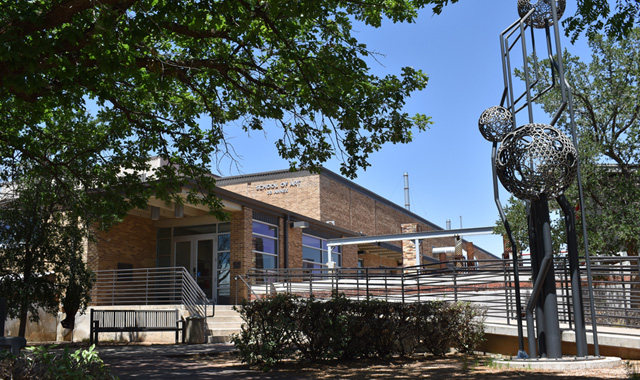

School of Art
About Us
about us
Currently, the School of Art enrolls 300 undergraduate majors, primarily from Texas and the Southwest. Our 65 full- and part-time graduate students, however, come from the US, Mexico, Palestine, Taiwan, Russia, Ukraine, and beyond. We operate four galleries in the Art Building and a Satellite Gallery at the downtown CASP/LHUCA Campus, annually presenting a slate of exhibitions and speakers programs. We annually present an undergraduate juried exhibition, an undergraduate art history symposium, an exhibition of faculty artworks, an art history faculty lecture series, a group graduate MFA candidate exhibition in the fall, and a group Studio BFA senior exhibition in the Spring. The Graphic Design students present their senior portfolio exhibitions each semester in the Studio Gallery. For several years we have collaborated with the local community to present the Low-Rider Bike / Dream Bike project. Through the Landmark Arts Exhibits and Speakers program, we also organize and present, biennially or triennially, the Texas Sculpture Symposium, Beyond Printmaking, Clay on the Wall, and for many years staged the nationally-recognized ColorPrint exhibition. Each semester a Speakers Series brings in three to five visiting artists, scholars, critics and other arts specialists from around the nation and world. Our faculty use the facilities of Texas Tech to host international academic symposia and the meetings of professional organizations such as the Society for Photographic Education. These activities introduce regional and national audiences to the excellent educational possibilities at TTU School of Art.
The SoA's faculty has grown in number and continues to excel in research. Of course, for the 32 full-time SoA faculty, research includes scholarly publications in art education and art history as well as the making of art. School of Art faculty have won the U.S. Presidential Higher Education Community Service Honor Roll Award for two consecutive years and have served as presidents of international organizations such as the Association of Latin American Art. Our faculty members publish, curate, and exhibit nationally and internationally.
Among the books published by our faculty are The Photographic Artifacts of Timothy O'Sullivan (1982), Yaxchilan: The Design of a Maya Ceremonial City (1992), The Mayan Enigma (1996), and Dogs Playing Cards: Powerbrokers of Prejudice in Education, Art and Culture (2004). Faculty have organized the scholarship of others around specific themes by editing journals such as Studies in Art Education and volumes such as Human Body/Human Spirit: A Portrait of Ancient Mexico (1995), Real-World Readings in Art Education: Things Your Professors Never Told You (2000), The Church of Santa Maria Donna Regina: Art, Iconography and Patronage in Fourteenth-Century Naples (2004); Art and Architecture in Naples 1266-1713 (2010), and Death and the Afterlife in the Early Modern Hispanic World (2010).
Works of art produced by our faculty are in museums such as the Getty, the Amon Carter, the Dallas Museum of Art, the Renwick (Smithsonian) and the Victoria and Albert (London). Our artists have participated in residency programs such as the American Antiquarian Society Research Fellowship for Creative and Performing Artists and Writers in Worcester, MA; the Nes Artist Residency in Skagaströnd, Iceland; and the Venice International School of Graphics. Galleries in Houston, Minneapolis, Los Angeles, Santa Fe, and beyond represent our faculty artists. Ceramics Monthly, ArtLies, Studio Visit Magazine, Voices of Art Magazine, and other publications have featured works by our artists. New works by members of the TTU faculty are selected for a wide range of national and international exhibitions, including the 2008 Pacific Rim International Print Exhibition in Christchurch, New Zealand; the 2009 Texas Biennial, and FOTOFEST in Houston.
Texas Tech's art historians have held research fellowships at the Clark Art Institute (MA), the Center for 17th– and 18th– Century Studies (UCLA), the National Gallery of Art, the Center for Advanced Studies in the Visual Arts at the National Gallery of Art, the Harvard Center for the Study of World Religions, the British School at Rome, the Centro Studi sulla Civiltà del Tardo Medioevo. Faculty have also curated exhibitions at the Museo Nacional de Bellas Artes (Argentina), the Dallas Museum of Art, the National Gallery of Art, the Houston Museum of Fine Arts, and at the University Museums of Princeton, Tufts, Santa Clara, and Emory.
Our faculty's creative energy and professional standards form the foundation for excellence in undergraduate and graduate education, and enable us to prepare students for successful careers as artists, educators, and art professionals.
It is only with support from many generous individuals and foundations that the School of Art has been able to continuously expand its programs and their quality. We are particularly appreciative of the Helen Jones Foundation for the generous and sustaining support of the Landmark Arts exhibition and speaker programs, the Saturday Morning Art Project, the triennial Clay on the Wall exhibition and ceramics symposium, the many years they supported the Color Print USA exhibitions, and their substantial support of the construction of the 3D Art Annex and the Helen DeVitt Jones Ceramics Studio. Thanks also go to The CH Foundation for their generous and sustaining support of the Landmark Arts exhibition and speaker programs and their support of the construction of the 3D Art Annex. We are grateful to the many individuals who have established scholarship endowments to support student excellence in their art careers. Special thanks go to John F. Lott for his vision in having established the Ryla T. and John F. Lott Endowment for Excellence in the Visual Arts which supports a major exhibition, program or symposium each semester. Many individuals in the Lubbock community continue to support the School of Art through the efforts of the Medici Circle. Their membership dues and the fundraisers organized by the Medici Circle have greatly increased scholarship support in the School of Art and provide much appreciated support.
history of the School of Art
When Texas Tech University (TTU) established the Department of Art in 1967, it held classes in the Home Economics building. Our first degree offering was the BFA in Studio Art and Graphic Design. Within a few years, we moved to the new Art Building—a construction that was added on to the Architecture building project—and initiated our first graduate programs, the Studio MFA and the multidisciplinary Fine Arts Doctoral program, in which students could select an Art major. In the mid-1970s the programs in Art Education began. We established a BS and MAE in Art Education. The BS was reconfigured first as a BFA in Art Education, then, in the 1990s, as a BFA in Visual Studies. By 1990, the Department had added a BA in Art History, and in 2010 launched the MA in Art History.
The Department of Art became the School of Art (SoA) in 2000. In 2002, TTU formed the College of Visual & Performing Arts (CVPA) to include the School of Art, School of Music, and Department of Theatre and Dance. Since 2007, with significant financial support from the Helen Jones Foundation and The CH Foundation, our facilities have expanded into the 3D Art Annex (a few blocks from the Art Building), which houses the disciplines of Jewelry Design and Metalsmithing, Ceramics, and Sculpture. During the 2007-2008 school year, Art celebrated its 40th anniversary. Former and current directors, faculty, and graduates converged to view three alumni exhibitions that represented the multiple decades of stimulating interaction between students and professors in Art. This event also honored the contributions made by many individuals to Art's growth in terms of size, but more importantly, in terms of commitments to excellence in teaching and research.
School of Art
-
Address
3010 18th Street | Box 42081, Lubbock, Texas 79409 -
Phone
806.742.3826 -
Email
art.info@ttu.edu

